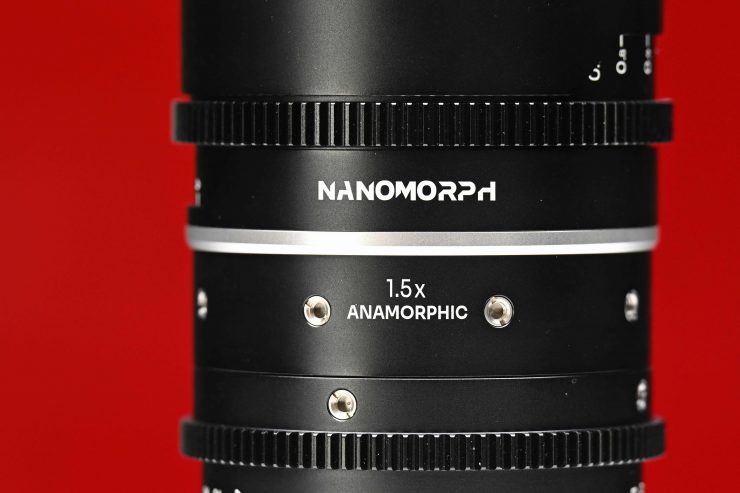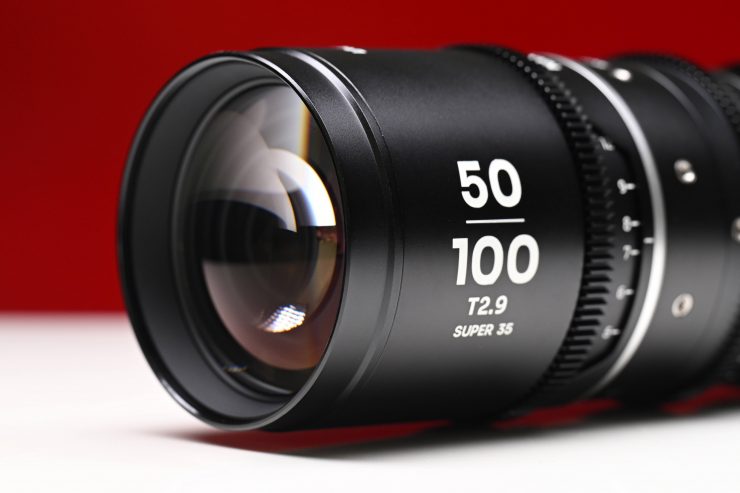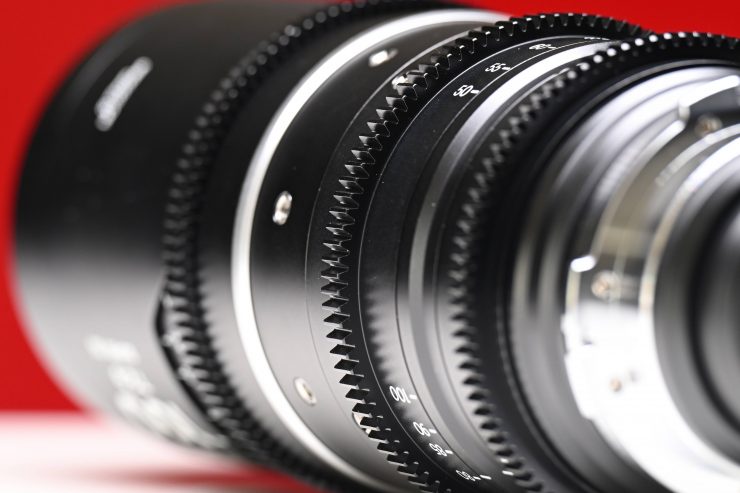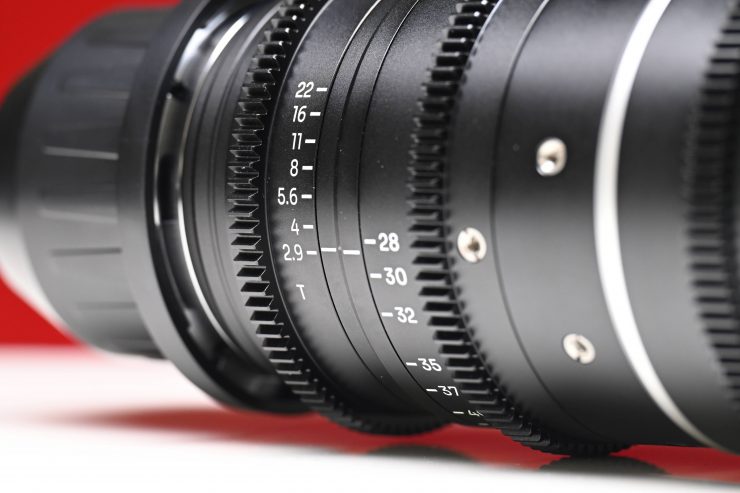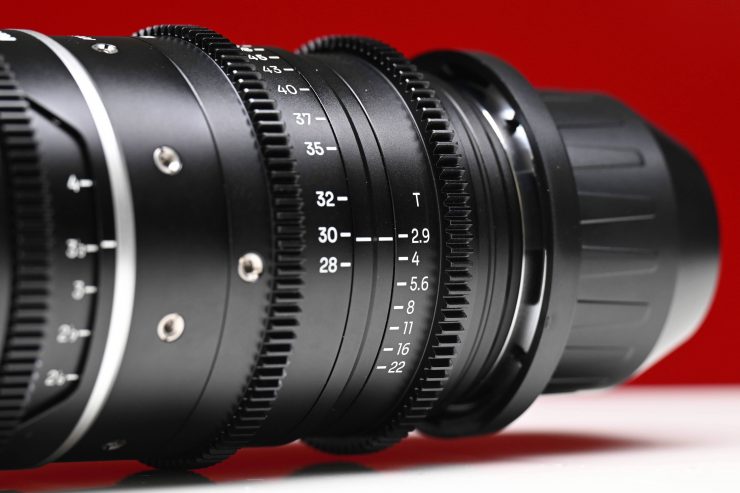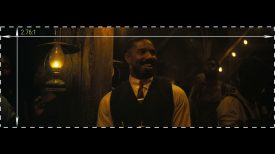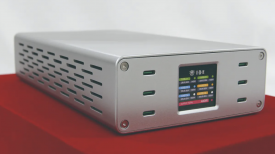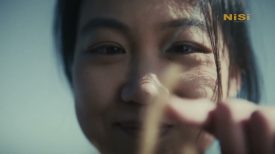
Laowa has officially announced its new Nanomorph 1.5X Anamorphic Zoom lens series for Super35 sensors. The series consists of the 28-55mm T2.9 and 50-100mm T2.9.

Both of the Nanomorph Zooms are 18.85cm / 7.42″ long and they weigh 1.52 kg / 3.35 lb. The design is very similar to Laowa’s Ranger Cine Zoom Series that I reviewed on the site last year.

Just like the Nanamorph 1.5x anamorphic primes, the Nanomorph Zooms are available in three different flare options: blue, amber, or silver.
Key features
- Revolutionary Compact Anamorphic Zoom
- Up to 3.6X Zoom Ratio
- Lightweight Design (~1.5kg)
- Constant 1.5X Squeeze Ratio
- Constant T2.9 Aperture
- Cinematic Flare with Amber/Blue/Silver Color Options
- Short Closest Focusing Distance of 45cm / 1’5” and 80cm /2’7”
We have seen a lot of affordable anamorphic primes hitting the market in the last few years, but anamorphic zooms are an entirely different story. The closest thing we have seen to an affordable anamorphic zoom was arguably the Ranger 28-75mm T2.9 & 75-180mm T2.9 Full Frame Zooms and the 1.33x front anamorphic adapter, and before that, the Laowa OOOM 25-100mm T2.9 Cine Lens Bundle which came with a 1.33x rear anamorphic adapter.
Laowa has a reputation for making unique and interesting lenses and they don’t follow what other manufacturers do.
Lens Design

Making anamorphic zooms is no easy task and that is why we haven’t seen any affordable options, that was until now.

I think what Laowa has done here is to morph (excuse the pun) the Nanomorph T2.4 1.5x S35 anamorphic primes with the Ranger zooms. The easiest way to think about it would be that you are getting an S35 1.5x anamorphic version of the Ranger zooms. Yes, that is oversimplifying things, but you get the general concept.
Focal Range

One of the biggest caveats of using a full-frame or larger sensor digital cinema camera is that the lenses become larger, heavier, and have reduced focal ranges. This is especially true when it comes to cine zooms that cover large image circles. Making full-frame 1.5x anamorphic zooms would have been difficult and costly, and Laowa wouldn’t have been able to keep them small and compact.

The focal ranges of 28-55mm and 50-100mm that the Nanomorph 1.5X Anamorphic Zooms offer are decent given their compact size and low weight. Yes, 100mm isn’t particularly long, but who knows, maybe we will see a longer focal length added in the future.

On an S35-sized sensor, 28mm for a 1.5x anamorphic is arguably wide enough for a lot of use cases. Having two lenses that can essentially cover the entire Nanamorph 1.5x T2.4 (PL & EF) prime line-up of 27, 35, 50, 65 & 80mm makes a lot of sense for solo shooters or small crews that want to shoot with anamorphic lenses, but don’t want to carry around 5 or 6 focal lengths.

Unfortunately, when it comes to optics you can’t have your cake and eat it too. You simply can’t have a full frame, lightweight anamorphic cine zoom with a decent constant T- stop and a big focal range. Yes, you can make your lens housing out of more exotic and expensive materials, but that is going to increase the price while only saving you a handful of weight. Staying with lenses that only cover S35 sensors makes the most sense given what Laowa is trying to do and who they are targeting the lenses at.
I am sure everyone would love to have a full frame 25-250mm T2.9 anamorphic cine zoom that weighs 2.5kg and costs $3,000 USD, well guess what, that is never going to happen. It is always going to be a compromise for lens manufacturers when it comes to weight, size, focal length, and T-stop.
Image Coverage

Both lenses will cover S35 sensors. I did notice that when shooting in 4.6K Open Gate on the ALEXA 35 there was a tiny bit of vignetting in the corners when using the 28-55mm, but when you are cropping for 2.39:1 you won’t see any.
First Impressions


Nanomorph 1.5X Anamorphic Zooms 
Ranger Full Frame Zooms
The lenses have a nice finish and they have minimal company branding on them and they are not trying to look pretentious or fancy. The zooms have the same understated look of the Nanamorph 1.5x T2.4 (PL & EF) primes. Above you can also see that both focal lengths are the same exact length, unlike the Ranger zooms.

If you buy the two-lens set, they come nicely presented in a custom hard case. The case with the lenses and accessories in it weighs in at 6.7kg / 14.77 lb.
Size & Weight

The Nanomorph 1.5X Anamorphic Zoom lenses weigh 1.52kg / 3.35 lb which makes them slightly heavier than the Ranger full-frame zooms that weigh 1.4 kg / 3.08 lb.
So, let’s put that weight into perspective by comparing it against some other anamorphic lenses on the market. Yes, this is a bit of an unfair comparison given the other options focal ranges, and 2x squeeze, but at least you can get an idea.
| WEIGHT | |
| Laowa 28-55 T2.9 Nanomorph 1.5X Anamorphic Zoom | 1.4 kg / 3.08 lb |
| Laowa 50-100 T2.9 Nanomorph 1.5X Anamorphic Zoom | 1.4 kg / 3.08 lb |
| P+S TECHNIK TECHNOVISION 1.5x 40-70mm T3.2 Full Frame Lens | 3.95 kg / 8.7 lb |
| P+S TECHNIK TECHNOVISION 1.5x 70-200mm T3.5 Full Frame Lens | 5.5 kg / 12.1 lb |
| ARRI Anamorphic 19-36mm T4.2 Ultra-Wide Zoom Lens | 5.5 kg / 12.13 lb |
| Angenieux Optimo Anamorphic 56-152mm Zoom Lens | 2.2 kg / 4.85 lb |
| Cooke 35-140mm 2x Anamorphic/i Zoom Lens | 10.3 kg / 22.7 lb |
As you can see, the Nanomorph zooms are pretty lightweight when compared against other anamorphic zooms.

The lenses are arguably more suitable for use with digital cinema cameras. Despite their relatively low weight, they are reasonably long.

While you could certainly use them on mirrorless hybrids, they are going to be better suited for use on S35 digital cinema cameras such as the ARRI ALEXA Mini, ARRI ALEXA 35, RED KOMODO, RED KOMODO X, etc.

Speaking of mirrorless hybrids, you can use the Nanomorph 1.5x anamorphic zooms with PL adapters that utilize rear drop-in filters.

Build Quality

What I personally look for when it comes to lenses is build quality and mechanical consistency. With expensive cine lenses, this is what you get, but with a lot of affordable cine lenses, this is often not the case. The build quality of more affordable cine lenses has gotten a lot better in recent years, but the mechanical consistency can still be very hit-and-miss. So, how are the Nanomorph zooms?
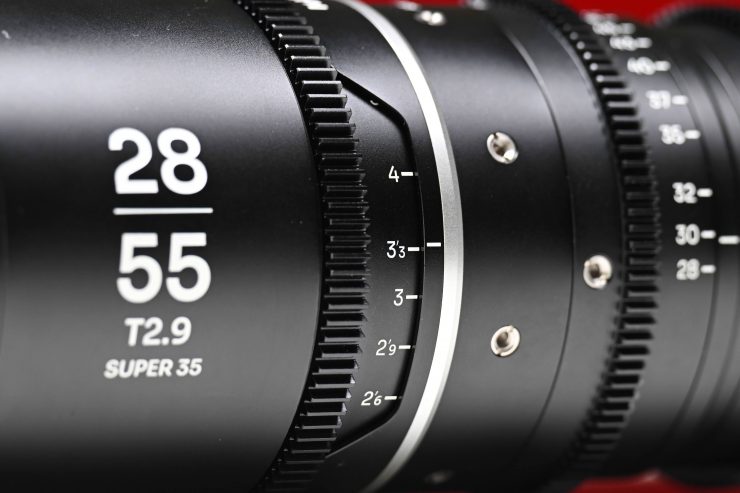
The Laowa T2.9 Nanomorph 1.5X Anamorphic Zooms have pretty consistent mechanics and build quality which was nice to see from affordably priced cine lenses.
The only slight negative I came across (and I am being very picky here) is that there is slightly more resistance in the focus rotation in the middle of the range than on the close and far ends with the 28-55mm T2.9.

The markings are clearly and concisely laid out and they are easy to see.

There are markings on both sides of the lenses. On the operator’s side of the lens, the focus markings are in feet, and on the non-operator side, they are in meters. All of the markings line up correctly which is what I would expect. Yes, it arguably would have been better to see two separate versions made in both feet or meters, but for affordable cine lenses that would just end up increasing the price.

The focus, iris, and zoom pitch gears are in the same position on both lenses so if you are running motors or a follow focus you don’t need to move them when changing over lenses. It is also nice that they both have the same weight and length so if you are using them on a gimbal, etc. then you don’t need to do any rebalancing.
Optical Design

The Nanomorph 1.5x zooms feature a front anamorphic design just like their prime counterparts.
The optical design of the 28-55mm T2.9 consists of 21 elements in 15 groups and the 50-100mm T2.9 has 20 elements in 14 groups. The 28-55mm T2.9 has 9 aperture blades and the 50-100mm T2.9 has 11.
The focus throw of both lenses is 270 degrees and the aperture throw is 41 degrees.
Constant 1.5x squeeze ratio

The Laowa Nanomorph zooms create a 1.5x horizontal field with the same vertical field of view as a similar spherical lens.
Some readers may be asking why 1.5x. Well, the main reason for going with 1.5x over 1.8x and 2x is that it is more suitable for multiple delivery aspect ratios yet it also preserves a lot of the same characteristics of a 2x anamorphic including oblong oval bokeh, barrel distortion, and shallow depth of field. Keeping to 1.5x also allows the lenses to be a lot smaller and lighter than their 1.8x and 2x counterparts. The other added benefit is that they are also more affordable to the end user.
A 1.5x squeeze can produce a widescreen 2.39:1 aspect when paired up with 4:3 or 3:2 sensors. When paired up with 16:9 sensors, much less data (than 2X anamorphic lens) is needed to be cropped away to create the desired 2.39:1 ratio.
In a lot of ways, the decision to go with a 1.5x anamorphic makes a lot more sense than going with a 2x. 1.5x is more versatile and it allows the lenses to be used on more cameras. Making a 1.5x anamorphic is also a lot easier than creating a 1.8x or 2x anamorphic.
2x with the 1.33x Front Anamorphic adapter

Now, if you want a 2x squeeze you can use the same 1.33x front anamorphic adapter that was designed for the Ranger full-frame zooms. By attaching it to the front of the Nanomorph 1.5x zooms you can increase the flexibility and versatility of the lenses.
I don’t have the 1.33x front anamorphic adapter to test with the lenses so I am not sure what type of results you could obtain.
Close Focus

The 28-55mm T2.9 and the 50-100mm T2.9 can focus at pretty close distances, 0.45m / 1.47′ with the 28-55mm and 0.8m / 2.62′ on the 50-100mm. They are also claimed to have very little focus breathing. I will test this later in the review.
So how does this close focus compare to some other anamorphic zooms on the market? Below you can see.
| MOD | |
| Laowa 28-55 T2.9 Nanomorph 1.5X Anamorphic Zoom | 0.45m / 1.47′ |
| Laowa 50-100 T2.9 Nanomorph 1.5X Anamorphic Zoom | 0.8m / 2.62′ |
| P+S TECHNIK TECHNOVISION 1.5x 40-70mm T3.2 Full Frame Lens | 0.72m / 2.36′ |
| P+S TECHNIK TECHNOVISION 1.5x 70-200mm T3.5 Full Frame Lens | 1.1m / 3.6′ |
| ARRI Anamorphic 19-36mm T4.2 Ultra-Wide Zoom Lens | 0.6m / 2′ |
| Angenieux Optimo Anamorphic 56-152mm Zoom Lens | 0.6m / 2.08′ |
| Cooke 35-140mm 2x Anamorphic/i Zoom Lens | 0.6m / 2.08′ |
As you can see, the Laowa 28-55 T2.9 has pretty good close-focus ability.
Other Features

Both the 28-55mm and 50-100mm have a 77mm filter thread and 80mm outer diameter, this allows you to use screw-in filters or a matte box.

They also have a rear focus adjustment built into the lens, however, unlike the one that is found on the Ranger full-frame zooms, you can’t easily access it. You need to remove the decorative bayonet ring and then loosen three screws to make an adjustment. The trouble with this design is that you can’t loosen those screws while the lens is on a camera. The only way to access them is with the lens removed, but then you need to make what is essentially a blind adjustment and then tighten the screws, and put the lens back on to check what you have done.
If the lenses aren’t exhibiting parfocal behavior you may need to add or remove shims (these come with the lenses).
When I asked Laowa about this whole process they told me that it is better to shim first and then fine-tune the back focus using the rear focus adjustment. I do wish the process was a little bit easier to do.

Both lenses come with 0.8 mod gears, threads for mounting lens support, and other utilities.

The zooms come in PL mount as standard, but there are optional Sony E, Canon RF, Nikon Z, Leica L, and Fuji X mounts also available. The mounts cost $50 USD each or $100 USD for a set.
Please note that EF mount version IS NOT available for the Nanomorph Zoom series due to its protruding rear elements.
The lenses are parfocal from my testing and they maintain focus regardless of the focal length.
Lens Breathing
I tested out the 50-100mm T2.9 at both 50mm and 100mm by doing large focus throws, and while there is a small amount of breathing, it is very well-contained for a lens at this price. I personally don’t like focus breathing as it can be very distracting, although with anamorphic lenses sometimes the breathing effect can be useful for creative intent.
Usually with anamorphic lenses you get breathing in the form of vertical stretching (when using them wide open), but it is good to see that the Nanomorph anamorphic zooms have minimal lens breathing.
Anamorphic breathing appears in a different way than when using a normal spherical lens. With a spherical lens, breathing gives the appearance that the focal length is changing. However, with anamorphic lenses, vertical stretching occurs with the background. So when you adjust focus from something close to something further away, the background takes on a squeezed appearance. Hence, this is why you see oval instead of round bokeh.
With anamorphic lenses, the more you stop the lens down, the less the out-of-focus object’s appearance will change. If you shoot wide open and pull focus the out-of-focus objects will change shape more dramatically.
Older anamorphic lenses such as Lomo’s and Kowa’s can breathe a lot. Newer anamorphic designs from companies such as Zeiss and Cooke have a lot less breathing. The popular Panavision E Series anamorphic lenses retain true anamorphic artifacts such as disproportional vertical focus breathing.
Sharpness
The growing trend that is common with a lot of the affordable cine zooms and primes these days is to come up with something a little more vintage, and that sometimes comes at the expense of sharpness. I was curious to see if the Laowa nanomorph 1.5x anamorphic zooms followed that trend. Above you can see how the 28-55mm T2.9 and 50-100mm T2.9 perform when used at various T-stops and focal lengths. The reason I shoot the small robot is that it has very finite details and textures on it. I also have shot countless sharpness tests with lenses using this same robot over the years so it allows me to have a baseline and comparison.
So what did I find? Well, let’s start with the 50-100mm T2.9
The 50-100mm is not that sharp when used at T2.9 @100mm, but it sharpens up pretty quickly at T4. By T5.6 it is nice and sharp.
At 75mm, the 50-100mm is a lot sharper at T2.9 than it is at 100mm. At T4 it is a little bit sharper, but not dramatically.
At 50mm, the 50-100mm has similar sharpness at T2.9 to when the lens is set at 75mm. 100mm. At T4 it is reasonably sharp without being jarring.
From my tests, I found that the 50-100mm T2.9 is certainly a lot sharper at its widest and mid-range focal lengths. At longer focal lengths the lens is softer, especially when used wide open.
The 28-55mm is sharp when used at T2.9 @28mm, and it gets slightly sharper at T4 and T5.6.
At 43mm, the 28-55mm is not as sharp at T2.9 as it was at 28mm. At T4 and T5.6 it does sharpen up.
At 55mm, the 28-55mm has similar sharpness at T2.9 to when the lens is set at 43mm, although perhaps it is arguably a touch softer. At T4 it gets quite a bit sharper.
From my tests, I found that the 28-50mm T2.9 is certainly a lot sharper at its widest focal lengths. At mid and longer focal lengths the lens is softer, especially when used wide open.
Lens Flare
I wasn’t sure what to expect with the Nanomorph zooms when it came to their flare characteristics. When I previously reviewed the mirrorless mount versions of the Nanomorph 1.5x primes I found the streaks to be too strong and not subtle.
I found with the Nanomorph zooms that the flare was a lot more subtle and softer, and arguably more in line with that of the Proteus 2x anamorphic primes. In saying that, I personally found the flares when using the 28-55mm T2.9 to be slightly nicer than those of the 50-100mm T2.9. With the 50-100mm T2.9, the streaks weren’t quite as soft.
The versions of the lenses I was testing had the Silver flare option, so I can’t tell you what the Blue and Amber versions look like.
Please have a look at the test footage further down in the review so you can see how the lenses perform when it comes to flare in real world conditions.
Chromatic Aberration
The lenses do show signs of chromatic aberration when used wide open. You can see some purple, red, and green chromatic aberration on bright surfaces or high-contrast environments when the lenses are used wide open.
The chromatic aberration is more noticeable with the 50-100mm T2.9 than it is with the 28-55mm T2.9. In saying that, it is pretty well-controlled and not overly distracting.
You will be able to see the chromatic aberration more clearly in my test footage further down in the review.
Color Consistency
With any lens series, you want the lenses to have a consistent look. I did a test to see if the 50-100mm T2.9 and the 28-55mm T2.9 had the same color tones. From my testing, I couldn’t tell any real-world noticeable difference between the two focal lengths.
Why were anamorphic lenses made?
What you may not know is that anamorphosing optics was developed by Henri Chrétien during World War I to provide a wide-angle viewer for military tanks. The optical process was called Hypergonar by Chrétien and was capable of showing a field of view of 180 degrees. After the war, anamorphic lenses for cinema were originally designed so that wide format imagery would fully utilize the film area of a standard 35 mm frame. The lenses also enhanced vertical resolution and reduced the appearance of grain. The technology was first used in a cinematic context in the short film Construire un Feu in 1927 by Claude Autant-Lara. The introduction of the Super 35mm format made the difference between anamorphic and spherical lenses a lot less obvious. This is because Super 35 provided more horizontal film area, as it didn’t have to record the audio next to each frame, as was the case with standard 35mm film.
Why shoot anamorphic?

With a lot of anamorphic lenses, you are going to see image imperfections, but this is what makes anamorphic lenses so special. With modern-day cameras and sensors being so good, a lot of DPs want to try and add character through the use of vintage or/and anamorphic lenses. Image characteristics when shooting with an anamorphic lens include the bokeh taking on the appearance of being oval-shaped as opposed to circular, and flares appear as bluish horizontal or vertical streaks which can span across the entire picture. The other characteristic associated with anamorphic shooting is the widescreen aspect ratio.

If you are working in HD or 2K formats with spherical lenses, you could just crop your 2K frame to get a 2.39:1 ratio, right? Yes, you could, but the problem is you are left with just 858 lines of vertical resolution. Anamorphic lenses provide a way to capture a 2.39:1 ratio without having to make that sacrifice in resolution. Of course, you can also capture at higher resolutions (4K, 6K, 8K, etc.) and then deliver in a lower resolution as well.
Anamorphic isn’t for everyone

As the old saying goes, just because you can, doesn’t mean you should. Anamorphics aren’t for everyone and they certainly won’t be suitable for a lot of projects. The very nature of their aspect ratio makes them difficult to use for a lot of content you may want to shoot. TV broadcasters often want a native 16:9 aspect ratio as they don’t want to have black bars below and above the image shown on their viewer’s screens. A lot of DPs would love to shoot anamorphic or even in a wider aspect ratio, but that can be vetoed by the network or broadcaster. Because the anamorphic-scope camera format does not preserve any of the images above and below the scope frame, it may not transfer as well to narrower aspect ratios, like the commonly used 16:9 for full-screen television.

You also need to take into account that the depth of field is also affected when shooting anamorphic-ally. Technically anamorphic and spherical lenses have the same depth of field, but in real-world use, you have to use a longer focal length with an anamorphic to achieve the same angle of view. This means at the same magnification (for example using a 35mm focal length), anamorphic lenses produce a shallower depth of field. As we all know, (whether you agree or not) the “cinematic” look is often associated with a shallower depth of field.
Reasons for not shooting anamorphic can include:
* Most anamorphic lenses can create artifacts or distortions
* Generally more expensive than spherical lenses
* A lot of anamorphic lenses are slower than spherical lenses and require more light
* Does not transfer well to narrower aspect ratios, such as 16:9
Real World Thoughts

The Laowa Nanomorph 1.5x anamorphic zooms are well-made, optically decent, lightweight, compact, and most importantly affordable. The lenses also have no direct competition and you have to applaud Laowa for what they have done here.

The relatively low weight and small size do mean that you could use them on smaller-sized digital cinema cameras and even mirrorless hybrids.
I went and took some shots with the lenses to see how they performed in the real world. Technical tests are all good and well but you really need to see how they perform in real-world environments both in terms of ease of use and lens performance.
Above you can see some footage captured with the lenses. I was interested to see how they performed at various focal lengths and what their usability was like when used wide open. I purposely wanted to push the lenses by shooting in very contrasty and difficult conditions. There isn’t much point in just shooting nice shots when testing out a lens. You want to push it optically to see what it does.

What I found is that they do produce quite a lot of veiling and other optical nuances when you shoot in heavily backlit environments. They also don’t maintain a lot of contrast in these situations. What I also found, and I suspect this is due to the coatings, is that in heavily backlit environments when you get direct light coming down the lens barrel, the lenses will throw a red and/or green tint onto your subject. This is something you need to be mindful of.
Now, a lot of people want funky flares and lens blooming, etc. when shooting with an anamorphic, so this is not necessarily a bad thing.
There is also noticeable chromatic aberration when shooting in very high-contrast environments.
The bokeh is ok, but I did find the fall-off was a little harsh for my taste.
There is some pin cushion distortion with the lenses, particularly at 28mm.
Optically the lenses are ok, but they don’t have a ‘wow’ factor. This didn’t come as a big shock because there aren’t any shortcuts when it comes to optics.

They are nice to operate and use, and the mechanics are good for lenses at this price. The small barrel size and compact nature make them easy to operate if you are working by yourself or in small crews. I also like that they are relatively lightweight and compact.

The overall optical performance of these lenses is decent. I thought the 50-100mm T2.9 might be a little soft at the long end when used wide open from my previous technical tests, but it was ok in real-world conditions. For anamorphic zooms the sharpness is ok, but they will be a little soft when used wide open.

A few years ago Laowa was arguably not as well known as other brands in the cine lens space, but I think with their recent offerings, a lot of people are very aware of who they are. Some people may have a preconceived bias that affordable cine lenses from China won’t be optically good. This is certainly not the case at all, and just as you should never judge a book by its cover, you should always judge a product on its merits and not based on a brand name.
Competition

The lenses don’t really have any competition, and I think that is what is bound to make them a popular option. There are so many affordable anamorphic prime lenses now available, but no zooms.
Price & Availability
The Laowa Nanomorph zooms will be available to pre-order on Indiegogo from March 1st, 2024 at GMT 14:00 / EST 09:00 / PST 06:00 / HKT 22:00. Please stay tuned for more product info. By signing up, supporters will be the first to know when the campaign goes live and will have access to early-bird perks and exclusive offers.
The Laowa Nanomorph zooms will be available to early backers for as low as $2,399 USD each, or $4,059 USD for the two lens set.
The regular Indiegogo price for a single lens will be $2,849 USD, or $5,509 USD for the 2-lens set.

Laowa is offering 10 perks in total, with discounts from 5% to 30% for single lenses or 2-lens sets. Additionally, Laowa is offering a 10% off deal for a special customized edition of the Nanomorph Zoom 2-lens set.
Laowa is also offering one of its backers the chance to get a Nanomorph Zoom lens in ARRI PL mount for only $1 USD.
So how does the price of the Laowa Nanomorph 1.5x anamorphic zooms cape to other options on the market? Below you can see.
| PRICE | |
| Laowa 28-50 T2.9 Nanomorph 1.5X Anamorphic Zoom | $2,849 USD |
| Laowa 50-100 T2.9 Nanomorph 1.5X Anamorphic Zoom | $2,849 USD |
| P+S TECHNIK TECHNOVISION 1.5x 40-70mm T3.2 Full Frame Lens | $28,300 USD |
| P+S TECHNIK TECHNOVISION 1.5x 70-200mm T3.5 Full Frame Lens | $33,000 USD |
| ARRI Anamorphic 19-36mm T4.2 Ultra-Wide Zoom Lens | $103,480 USD |
| Angenieux Optimo Anamorphic 56-152mm Zoom Lens | $56,333 USD |
| Cooke 35-140mm 2x Anamorphic/i Zoom Lens | $59,900 USD |
Above you can see what some other anamorphic cine zooms with similar focal ranges cost. The Laowa Nanomorph 1.5x zooms certainly don’t have any direct competition at their price.
What do you get?

If you buy the two-lens kit for $ USD comes in a nice custom hard case and inside you get the lenses, shims, tools, and lens supports.

Conclusion

Laowa has certainly come up with two unique zooms that have no direct competition at their price. The Nanomorph 1.5x zooms finally give shooters the ability to purchase anamorphic zooms that were previously out of reach for most people. The Nanomorph zooms offer great bang for your buck and they will work well with the Nanomorph (PL & EF mount) primes.
No, the lenses aren’t going to be optically perfect, but that is always going to be the case with the majority of budget-friendly cine zooms. You also have to remember that a lot of anamorphic zooms (even the expensive ones) are not optically perfect either. The lenses certainly have their quirks, and like a lot of optics, it will come down to a users individual tastes as to whether they like the Nanomorph zooms or not.
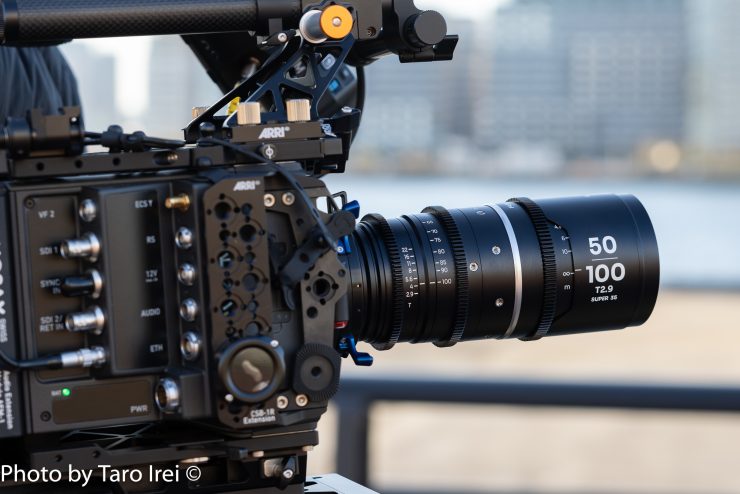
Yes, Laowa has undoubtedly had to make some compromises and juggle optical performance with size and weight to come up with a good solution, but in saying that, they have decent sharpness (when stopped down slightly), and the focus breathing is well controlled. The mechanics of the lenses are also very good considering their cost, and most importantly, they are easy to use and operate.
The flare and optical characteristics may not be to everyone’s taste, although I preferred it to the mirrorless mount Nanomorph primes that I reviewed on the site a few years ago. They do produce a fair bit of veiling and they certainly have some quirky optical characteristics, but that arguably probably adds to their appeal.

The lenses are light enough and small enough that you could use them on a wide array of different cameras.
The biggest benefit of lenses with a PL mount is that you can use them on almost any camera, whereas if you choose other mounts, you are predominantly locked into using those lenses on a select number of cameras.

As I always say, there are no shortcuts with optics, and if you want to make anamorphic cine zoom lenses that have this focal range with this weight and size you will need to cut some corners. Laowa has managed to just trim the corners without having to cut them off completely. As I previously mentioned they are far from perfect optically, but for their price, they do a good job.
There is a certain irony when you hear people complaining about the prices of lenses we now have available. 10 years ago lenses like these would have cost at least $25,000 USD each. I still find the fact that you can buy two anamorphic cine zooms with a constant T2.9 stop, with these focal ranges, for under $5800 USD mind-boggling. No, I don’t for one second expect that they are going to be able to go head-to-head with lenses that cost 20x more, but you know what, they do a very good job considering the massive price difference.
It is great to finally see some affordable anamorphic cine zooms becoming available. If you are an owner/operator, lenses such as these make a lot of sense. Anamorphic zooms have historically been out of reach and their prohibitive cost has made a lot of them rental-only items. The Laowa Nanomorph 1.5x anamorphic zooms won’t empty your wallet and they provide decent results. Are they not going to offer the same optical quality as more expensive offerings, no, probably not, but they still get the job done for far less money and that is their biggest appeal.



